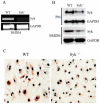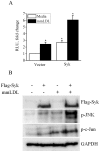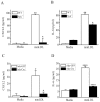Spleen tyrosine kinase regulates AP-1 dependent transcriptional response to minimally oxidized LDL
- PMID: 22384232
- PMCID: PMC3284564
- DOI: 10.1371/journal.pone.0032378
Spleen tyrosine kinase regulates AP-1 dependent transcriptional response to minimally oxidized LDL
Abstract
Oxidative modification of low-density lipoprotein (LDL) turns it into an endogenous ligand recognized by pattern-recognition receptors. We have demonstrated that minimally oxidized LDL (mmLDL) binds to CD14 and mediates TLR4/MD-2-dependent responses in macrophages, many of which are MyD88-independent. We have also demonstrated that the mmLDL activation leads to recruitment of spleen tyrosine kinase (Syk) to TLR4 and TLR4 and Syk phosphorylation. In this study, we produced a macrophage-specific Syk knockout mouse and used primary Syk(-/-) macrophages in our studies. We demonstrated that Syk mediated phosphorylation of ERK1/2 and JNK, which in turn phosphorylated c-Fos and c-Jun, respectively, as assessed by an in vitro kinase assay. c-Jun phosphorylation was also mediated by IKKε. c-Jun and c-Fos bound to consensus DNA sites and thereby completed an AP-1 transcriptional complex and induced expression of CXCL2 and IL-6. These results suggest that Syk plays a key role in TLR4-mediated macrophage responses to host-generated ligands, like mmLDL, with subsequent activation of an AP-1 transcription program.
Conflict of interest statement
Figures






Similar articles
-
SYK regulates macrophage MHC-II expression via activation of autophagy in response to oxidized LDL.Autophagy. 2015;11(5):785-95. doi: 10.1080/15548627.2015.1037061. Autophagy. 2015. PMID: 25946330 Free PMC article.
-
Macrophages generate reactive oxygen species in response to minimally oxidized low-density lipoprotein: toll-like receptor 4- and spleen tyrosine kinase-dependent activation of NADPH oxidase 2.Circ Res. 2009 Jan 30;104(2):210-8, 21p following 218. doi: 10.1161/CIRCRESAHA.108.181040. Epub 2008 Dec 18. Circ Res. 2009. PMID: 19096031 Free PMC article.
-
Toll-like receptor 4-dependent and -independent cytokine secretion induced by minimally oxidized low-density lipoprotein in macrophages.Arterioscler Thromb Vasc Biol. 2005 Jun;25(6):1213-9. doi: 10.1161/01.ATV.0000159891.73193.31. Epub 2005 Feb 17. Arterioscler Thromb Vasc Biol. 2005. PMID: 15718493
-
The SYK side of TLR4: signalling mechanisms in response to LPS and minimally oxidized LDL.Br J Pharmacol. 2012 Nov;167(5):990-9. doi: 10.1111/j.1476-5381.2012.02097.x. Br J Pharmacol. 2012. PMID: 22776094 Free PMC article. Review.
-
Toll-like receptor-4 and lipoprotein accumulation in macrophages.Trends Cardiovasc Med. 2009 Oct;19(7):227-32. doi: 10.1016/j.tcm.2010.02.001. Trends Cardiovasc Med. 2009. PMID: 20382346 Free PMC article. Review.
Cited by
-
Polyoxygenated cholesterol ester hydroperoxide activates TLR4 and SYK dependent signaling in macrophages.PLoS One. 2013 Dec 23;8(12):e83145. doi: 10.1371/journal.pone.0083145. eCollection 2013. PLoS One. 2013. PMID: 24376657 Free PMC article.
-
[Liuwei Buqi capsule modulates immune function by targeting multiple immune cell subsets in lung tissue of patients with COPD].Nan Fang Yi Ke Da Xue Xue Bao. 2021 Oct 20;41(10):1492-1500. doi: 10.12122/j.issn.1673-4254.2021.10.07. Nan Fang Yi Ke Da Xue Xue Bao. 2021. PMID: 34755664 Free PMC article. Chinese.
-
Electronegative LDL: a circulating modified LDL with a role in inflammation.Mediators Inflamm. 2013;2013:181324. doi: 10.1155/2013/181324. Epub 2013 Aug 22. Mediators Inflamm. 2013. PMID: 24062611 Free PMC article. Review.
-
Nanocluster-mediated signaling crosstalk between FcγR and TLR4 in macrophage inflammatory responses.Sci Rep. 2025 Apr 14;15(1):12856. doi: 10.1038/s41598-025-96679-z. Sci Rep. 2025. PMID: 40229305 Free PMC article.
-
SYK regulates macrophage MHC-II expression via activation of autophagy in response to oxidized LDL.Autophagy. 2015;11(5):785-95. doi: 10.1080/15548627.2015.1037061. Autophagy. 2015. PMID: 25946330 Free PMC article.
References
-
- Jakus Z, Fodor S, Abram CL, Lowell CA, Mocsai A. Immunoreceptor-like signaling by [beta]2 and [beta]3 integrins. Trends in Cell Biology. 2007;17:493–501. - PubMed
-
- Woodside DG, Obergfell A, Talapatra A, Calderwood DA, Shattil SJ, et al. The N-terminal SH2 Domains of Syk and ZAP-70 Mediate Phosphotyrosine-independent Binding to Integrin Cytoplasmic Domains. J Biol Chem. 2002;277:39401–39408. - PubMed
Publication types
MeSH terms
Substances
Grants and funding
LinkOut - more resources
Full Text Sources
Other Literature Sources
Molecular Biology Databases
Research Materials
Miscellaneous

